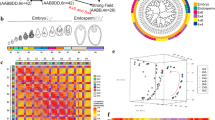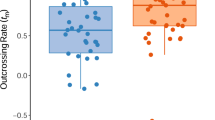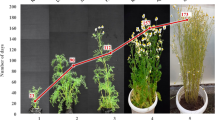Abstract
Anther-stigma separation (herkogamy) is highly variable within populations of Mimulus ringens, a bumblebee-pollinated perennial herb with a mixed-mating system. The relationship between this floral trait and individual outcrossing rates was studied in two experimental populations composed of genets with unique multilocus combinations of homozygous genotypes. This facilitated determination of individual outcrossing rates through unambiguous assignment of paternity to all 1560 sampled progeny. In each population there was significant heterogeneity among maternal families in frequencies of self and outcross progeny. Individual outcrossing rates were positively correlated with anther-stigma separation.
Similar content being viewed by others
Article PDF
References
Barrett, S C H, and Eckert, C G. 1990. Variation and evolution of mating systems in seed plant. In: Kawano, S. (ed.) Biological Approaches and Evolutionary Trends in Plants, pp. 229–254. Academic Press, London.
Barrett, S C H, Lloyd, D G, and Arroyo, J. 1996. Stylar polymorphisms and the evolution of heterostyly in Narcissus (Amaryllidaceae). In: Lloyd, D. G. and Barrett, S. C. H (eds) Floral Biology: Studies on Floral Evolution in Animal-Pollinated Plants, pp. 339–376. Chapman&Hall, London.
Belaoussoff, S, and Shore, J S. 1995. Floral correlates and fitness consequences of mating-system variation in Turnern ulmifolia. Evolution, 49, 545–556.
Boshier, D H, Chase, M R, and Bawa, K S. 1995. Population genetics of Cordia alliodora (Boraginaceae), a neotropical tree. 2. Mating system. Am J Bot, 82, 476–483.
Brown, A H D. 1990. Genetic characterization of plant mating systems. In: Brown, A. H. D., Clegg, M. T., Kahler, A. L. and Weir, B. S. (eds) Plant Population Genetics, Breeding, and Genetic Resources, pp. 145–162. Sinauer, Sunderland, MA.
Brown, A H D, Burdon, J J, and Jarosz, A M. 1989. Isozyme analysis of plant mating systems. In: Soltis, D. E. and Soltis, P. S. (eds) Isozymes in Plant Biology, pp. 73–86. Dioscorides Press, Portland, OR.
Carr, D E, and Fenster, C B. 1994. Levels of genetic variation and covariation for Mimulus (Scrophulariaceae) floral traits. Heredity, 72, 606–618.
Cruzan, M B, Hamrick, J L, Arnold, M L, and Bennett, B D. 1994. Mating system variation in hybridizing irises: effects of phenology and floral densities on family outcrossing rates. Heredity, 72, 95–105.
Damgaard, C, and Loeschcke, V. 1994. Genotypic variation for reproductive characters, and the influence of pollen-ovule ratio on selfing rate in rape seed (Brassica napus). J Evol Biol, 7, 599–607.
Dole, J A. 1991. Evolution of Mating Systems in the Mimulus guttatus Complex. Ph.D. Dissertation, University of California, Davis.
Dole, J A. 1992. Reproductive assurance mechanisms in three taxa of the Mimulus guttatus complex (Scrophular-iaceae). Am J Bot, 79, 650–659.
Dudash, M R, and Ritland, K. 1991. Multiple paternity and self-fertilization in relation to floral age in Mimulus guttatus (Scrophulariaceae). Am J Bot, 78, 1746–1753.
Ellstrand, N C. 1984. Multiple paternity within the fruits of the wild radish, Raphanus sativus Am Nat, 123, 819–828.
Ennos, R A. 1981. Quantitative studies of the mating system in two sympatric species of Ipomoea (Convolvulaceae). Genetica, 57, 93–98.
Epperson, B K, and Clegg, M T. 1987. First-pollination primacy and pollen selection in the morning glory, Ipomoea purpurea. Heredity, 58, 5–14.
Falconer, D S. 1981. Introduction to Quantitative Genetics, 2nd edn. Longman, New York.
Fenster, C B, and Ritland, K. 1994. Quantitative genetics of mating system divergence in the yellow monkey-flower species complex. Heredity, 73, 422–435.
Grant, A L. 1924. A monograph of the genus Mimulus. Ann Mo Bot Gard, 11, 99–388.
Holsinger, K E. 1992. Ecological models of plant mating systems and the evolutionary stability of mixed mating systems. In: Wyatt, R. E. (ed.) Ecology and Evolution of Plant Reproduction, pp. 169–191. Chapman&Hall, London.
Holtsford, T P, and Ellstrand, N C. 1992. Genetic and environmental variation in floral traits affecting outcrossing rate in Clarkia tembloriensis (Onagraceae). Evolution, 46, 216–225.
Humphreys, M O, and Gale, J S. 1974. Variation in wild populations of Papaver dubium. VII. The mating system. Heredity, 33, 33–42.
Jarne, P, and Charlesworth, D. 1993. The evolution of the selfing rate in functionally hermaphrodite plants and animals. Ann Rev Ecol Syst, 24, 441–466.
Karron, J D. 1997. Genetic consequences of different patterns of distribution and abundance. In: Kunin, W. E. and Gaston, K. J. (eds) The Biology of Rarity, pp. 174–189. Chapman&Hall, London.
Karron, J D, Thumser, N N, Tucker, R, and Hessenauer, A J. 1995a. The influence of population density on outcrossing rates in Mimulus ringens. Heredity, 75, 175–180.
Karron, J D, Tucker, R, Thumser, N N, and Reinartz, J A. 1995b. Comparison of pollinator flight movements and gene dispersal patterns in Mimulus ringens. Heredity, 75, 612–617.
Kohn, J R, and Barrett, S C H. 1994. Pollen discounting and the spread of a selfing variant in tristylous Eichhor-nia paniculata: evidence from experimental populations. Evolution, 48, 1576–1594.
Leclerc-Potvin, C, and Ritland, K. 1994. Modes of self-fertilization in Mimulus guttatus (Scrophulariaceae): a field experiment. Am J Bot, 81, 199–205.
Lloyd, D G, and Schoen, D J. 1992. Self- and cross-fertilization in plants. I. Functional dimensions. Int J Plant Sci, 153, 358–369.
Morgan, M T, and Barrett, S C H. 1990. Outcrossing rates and correlated mating within a population of Eichhornia paniculata (Pontederiaceae). Heredity, 64, 271–280.
Motten, A F, and Antonovics, J. 1992. Determinants of outcrossing rate in a predominantly self-fertilizing weed, Datura stramonium (Solanaceae). Am I Bot, 79, 419–427.
Murawski, D A, and Hamrick, J L. 1992. Mating system and phenology of Ceiba pentandra (Bombacaceae) in Central Panama. J Hered, 83, 401–404.
Rick, C M, Fobes, J F, and Holle, M. 1977. Genetic variation in Lycopersicon pimpinellifolium: Evidence of evolutionary change in mating systems. PL Syst Evol, 127, 139–170.
Ritland, C, and Ritland, K. 1989. Variation of sex allocation among eight taxa of the Mimulus guttatus species complex. Am J Bot, 76, 1731–1739.
Ritland, K. 1990. A series of FORTRAN computer programs for estimating plant mating systems. J Hered, 81, 235–237.
Ritland, K, and Ganders, F R. 1985. Variation in the mating system of Bidens menziesii (Asteraceae) in relation to population substructure. Heredity, 55, 235–244.
Ritland, K, and Ganders, F R. 1987. Covariation of selfing rates with parental gene fixation within populations of Mimulus guttatus. Evolution, 41, 760–771.
Ritland, K, and Jain, S. 1981. A model for the estimation of outcrossing rate and gene frequencies using n independent loci. Heredity, 47, 35–52.
Robertson, A W, Diaz, A, and Macnair, M R. 1994. The quantitative genetics of floral characters in Mimulus guttatus. Heredity, 72, 300–311.
Sas Institute. 1990. SASISTAT User's Guide, Version 6, 4th edn. SAS Institute, Cary, NC.
Smyth, C A, and Hamrick, J L. 1984. Variation in estimates of outcrossing in musk thistle populations. J Hered, 75, 303–307.
Steel, R G D, and Torrie, J H. 1980. Principles and Procedures of Statistics: a Biometrical Approach, 2nd edn. McGraw-Hill, New York.
Sutherland, S, and Vickery, R K. 1988. Trade-offs between sexual and asexual reproduction in the genus Mimulus. Oecologia, 76, 330–335.
Waller, D M. 1993. The statics and dynamics of mating system evolution. In: Thornhill, N. W. (ed.) The Natural History of Inbreeding and Outbreeding, pp. 97–117. University of Chicago Press, Chicago.
Warwick, S I, and Thompson, B K. 1989. The mating system in sympatric populations of Carduus nutans, Carduus acanthoides and their hybrid swarms. Heredity, 63, 329–338.
Webb, C J, and Lloyd, D G. 1986. The avoidance of interference between the presentation of pollen and stigmas in angiosperms. II. Herkogamy. N Z J Bot, 24, 163–178.
Author information
Authors and Affiliations
Corresponding author
Rights and permissions
About this article
Cite this article
Karron, J., Jackson, R., Thumser, N. et al. Outcrossing rates of individual Mimulus ringens genets are correlated with anther–stigma separation. Heredity 79, 365–370 (1997). https://doi.org/10.1038/hdy.1997.169
Received:
Issue date:
DOI: https://doi.org/10.1038/hdy.1997.169



